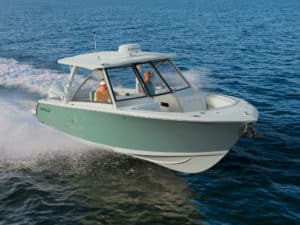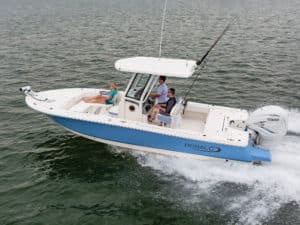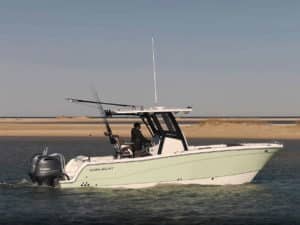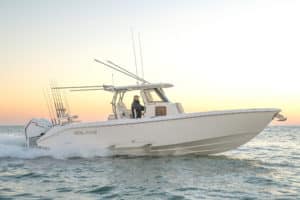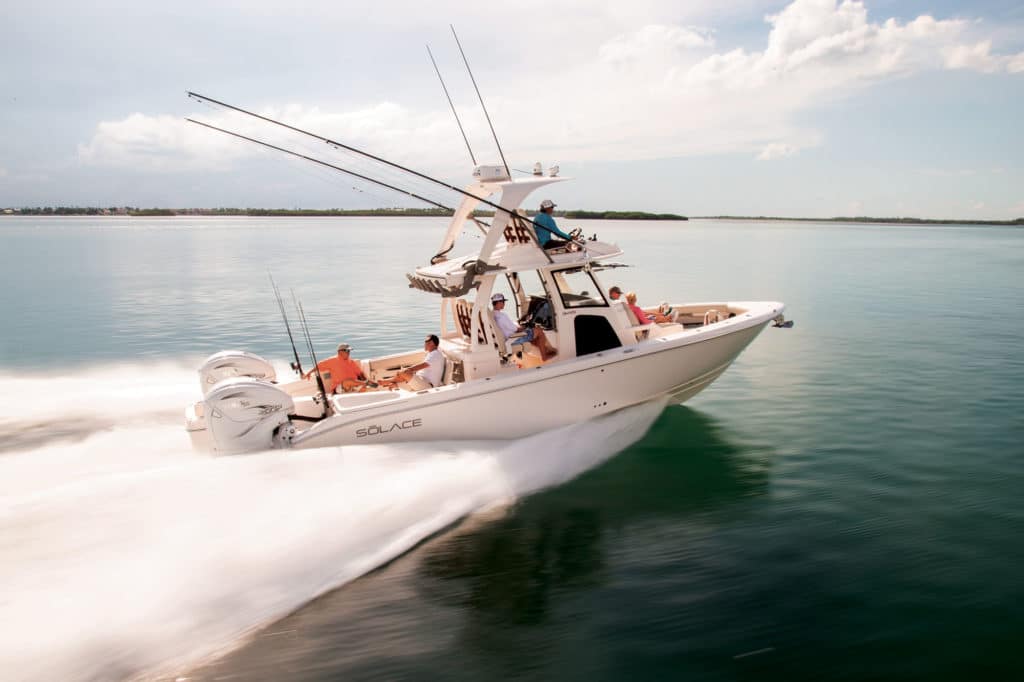
On this August day, the pre-dawn sky above Stuart, Florida, played host to one of humankind’s most advanced feats. While preparing to board my test boat at Pirates Cove Marina, I witnessed a Saturn 5 rocket streak toward space. Launched moments earlier at Cape Canaveral, its billowing contrail was illuminated by rays of a sun still hidden below the horizon. I stood mesmerized, watching the payload slip the surly bonds of Earth.
How apropos, I thought, because this fish trial focuses on one of today’s most advanced center-console-boat designs, the Solace 345. The Edgewater, Florida-based brand is new, but its co-founder, CEO and chief designer, Stephen Dougherty, boasts a vaunted boatbuilding pedigree. His father, Bob Dougherty, served for decades as a chief designer for Boston Whaler, then founded EdgeWater Power Boats and subsequently Everglades Boats.
Stephen Dougherty developed his design skills at all three companies (and co-owned the latter two), applying out-of-the-box, trendsetting ideas to fishing boats. That penchant for innovation has carried over big-time with the launch of the Solace 345.
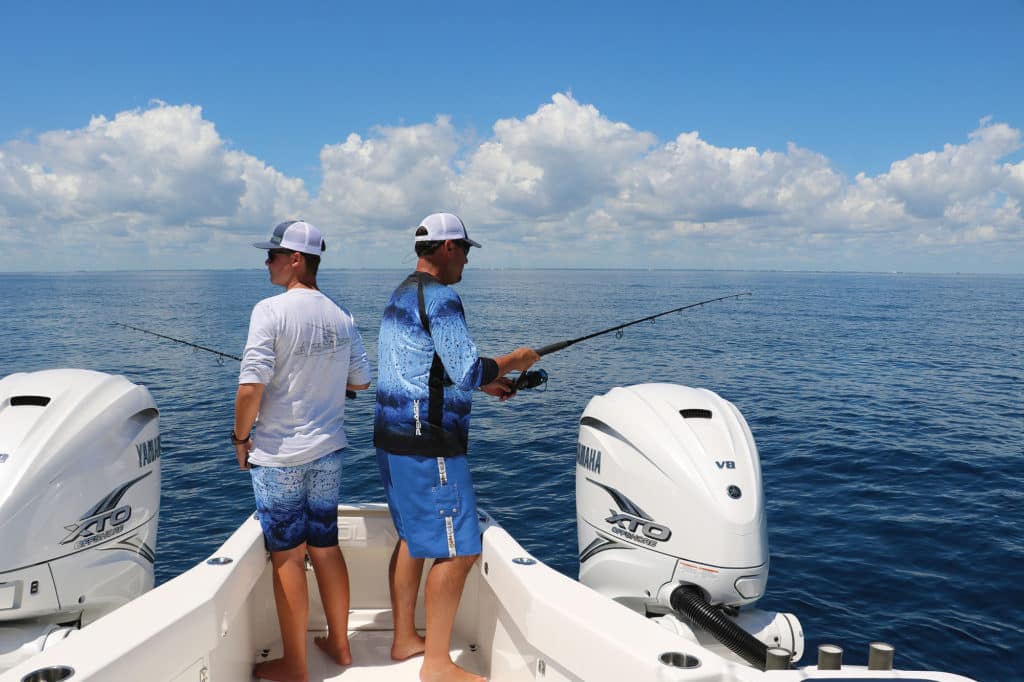
Looking Astern I was joined on test day by Solace president Todd Albrecht; his teenage son, Connor; Solace communications manager John Moe; and Sport Fishing group publisher Scott Salyers. Once aboard the 345, I immediately gravitated to the most prominent feature—the patented FishThru transom design includes a platform that extends aft between and beyond twin outboards that are installed on the outer edges of the hull.
“A lot of people look at the transom and think this is a catamaran,” Albrecht said as we cruised out toward St. Lucie Inlet en route to a wreck to catch bait and then head offshore to slow-troll for mahi.
Due to the unique design of the 345, Albrecht finds himself constantly answering questions by onlookers. “I tell them it’s a monohull, and sometimes they don’t seem to believe me.” Indeed, the 345 rides on a deep-V hull with 34 feet of running surface and 22 degrees of deadrise at the transom.
We navigated to the wreck using the twin Garmin GPSMap 8617 multifunction displays flush-mounted in the 53-inch-wide dash panel. The fish finder showed large schools of bait over the structure. As we dropped sabiki rigs to catch threadfin herring and small blue runners, I instantly recognized the value of the FishThru transom for working lines around protruding outboards, which can prove difficult on conventional extended transoms.
Two anglers can fish side by side on the platform, which features 23-inch-high gunwales. The deck tapers from 42 inches wide at the transom to 38 inches wide at the aft end. A pair of gunwale rod holders brackets the 52-inch-long platform, which sits above the waterline, so it’s not part of the running surface. It features a beefy dive door and a hydraulic extension that serves as a swim platform, which includes a foldout boarding ladder.
Offshore Run The crew quickly filled the twin pressurized 45-gallon livewells with bait; liveys fared extremely well with nary a one dying before its time. These covered wells flank the FishThru transom, and each features an adjacent tuna tube. All are served by an innovative sea chest integrated into the stringer system of the 345.
We stowed the sabiki rods in the hardtop rod holders (there are eight) and transferred the offshore sticks to the three-rod racks on each side of the transom, then headed for blue water.
I wondered how well the propellers would stay hooked up, given the engines’ unconventional locations at the outer edges of the hull. This was a nonissue in my test. The props refused to relinquish their bite, even while cornering at speed and traversing choppy seas.
The 345 trims out like any other outboard-powered V-hull, and it responds promptly to the Zipwake trim-tab system. These vertical tabs are installed, by necessity, inboard of the twin engines.
My test boat came equipped with the optional Seakeeper 2 gyrostabilizer. This DC-powered system eliminates roll. It also keeps the boat on an even keel while underway, and that means you don’t need to use the tabs to correct for weight or load shifts, only to help adjust the trim angle.
As we crested the waves at the inlet and beyond, I could sense the solid construction of the hull, which features a carbon-fiber, Innegra-fiber and epoxy laminate that is vacuum-infused and oven-cured for high strength and durability.
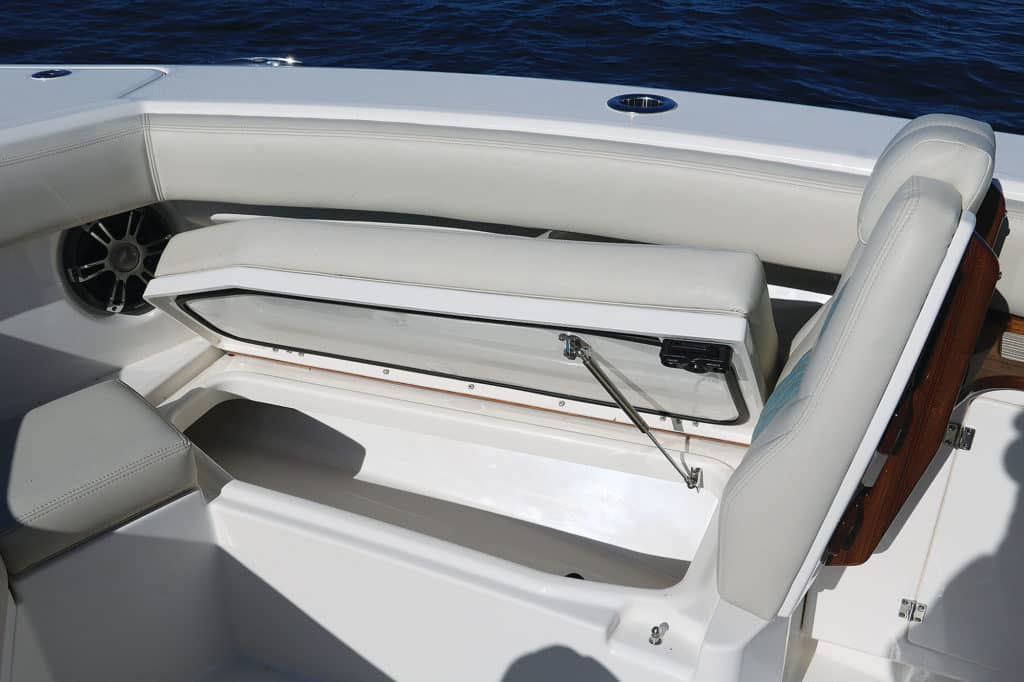
Helm Comfort I joined Albrecht at the helm, settling into one of the three high-back Llebroc Billfish chairs, featuring fold-down armrests and bolsters. Each is mounted on a Shockwave S5 base to help enhance comfort in rough seas. A footrest at the base of the console let me prop up my feet.
When it came time to stand, I appreciated the extra cushion provided by the SeaDek helm pad with an extra 4 inches of shock-mitigating closed-foam EVA underneath. To top it off, the helm pad sits on a riser that can hydraulically elevate as much as 10 inches for extra height while standing at the wheel.
The wraparound tempered-glass windshield blends seamlessly with the hardtop. The windshield also hinges upward on hydraulic actuators to allow for a cooling breeze on sultry days.
Two Scanstrut Rokk wireless, waterproof charging mounts secure cellphones at the helm, and dual glove boxes let you stash small items like car keys, sunglasses and tubes of sunscreen. All switching is digital, including activation of the 345’s hydraulic systems.
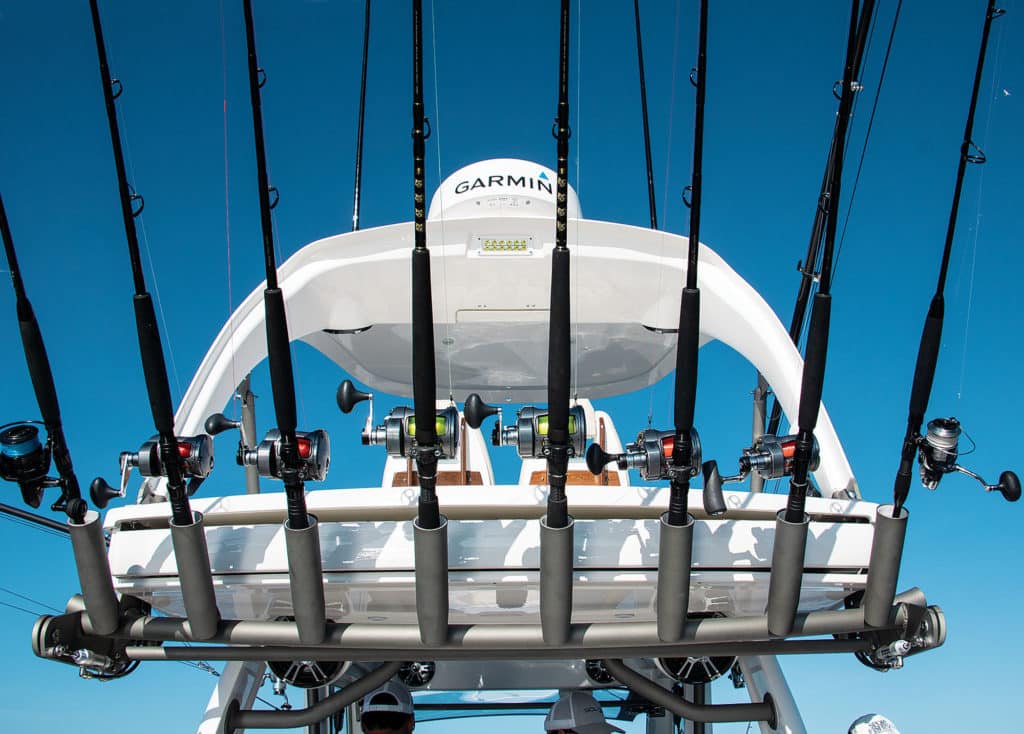
Getting High My test boat came equipped with another innovation: the optional half-tower/second station. Its two inviting high-back helm seats come with flip-up bolsters; a carbon-fiber buggy top provides shade, and serves as a mounting surface for antennas and a radar dome. As we arrived at the offshore grounds and the crew set out four live baits (two from the standard Taco composite outriggers and two from flat lines), I decided to ascend to the tower to scout for weed lines, birds and fish.
With a footrest to prop up my feet, this perch aloft proved supremely comfortable and offered a full set of controls, including a second joystick for the standard Yamaha Helm Master docking system and a Garmin GPSMap 7612xsv that is networked with the main MFDs. Those who wish to trailer this boat will appreciate the foldaway feature of the buggy top. “It is very easy to fold up and down,” Albrecht says. “Two people can do it in a few minutes.” For those down on deck, the 345 also features an Amerishade cockpit shade that extends electrically from inside the hardtop. The hardtop rod rack tilts down to allow the shade to deploy.
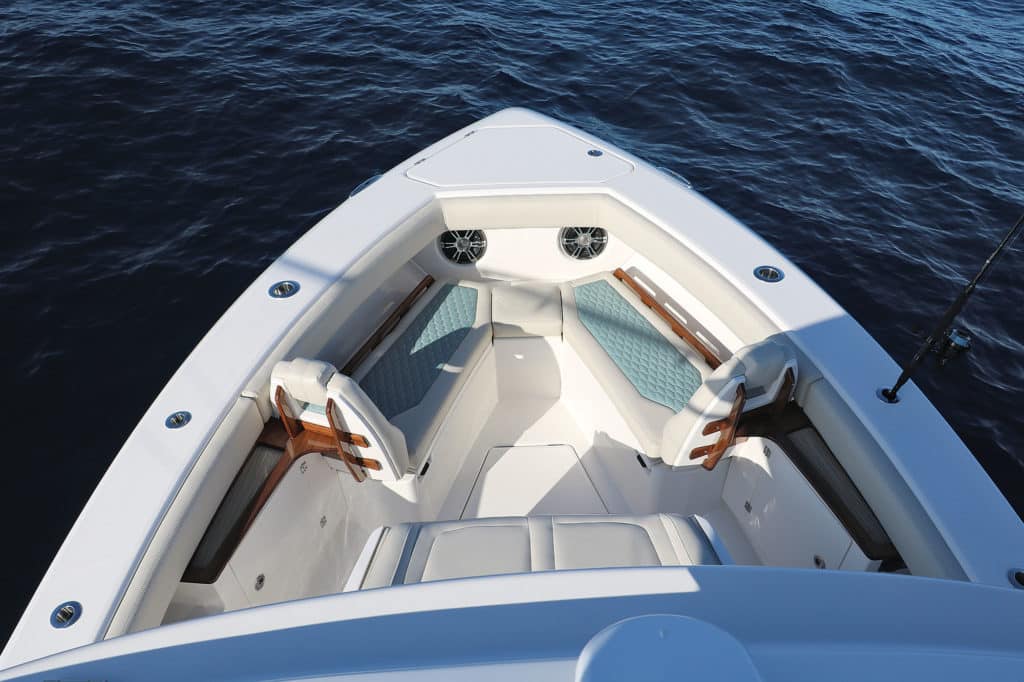
Luxury Interior While waiting for a bite, I climbed down to check out the rest of the 345, starting with the console interior, which is accessible via a portside door with the beefiest stainless-steel hinge I have seen on a boat of this size. It allows the door to articulate to provide wide access and avoid blocking the walk-through when opened.Inside, I found 77 inches of headroom and pure luxury in the form of dark wood cabinetry, a vanity with a Corian countertop, an illuminated glass vessel sink, an electric-flush marine toilet, a settee that converts to a berth, a microwave, a 6,000 Btu air-conditioning system, and more.
Back on deck, the 345 abounds with seating. I tried out the 42-inch-long two-person lounger on the forward console, as well as the twin 44-inch-long loungers in the bow. I had to force myself to get up and keep exploring.
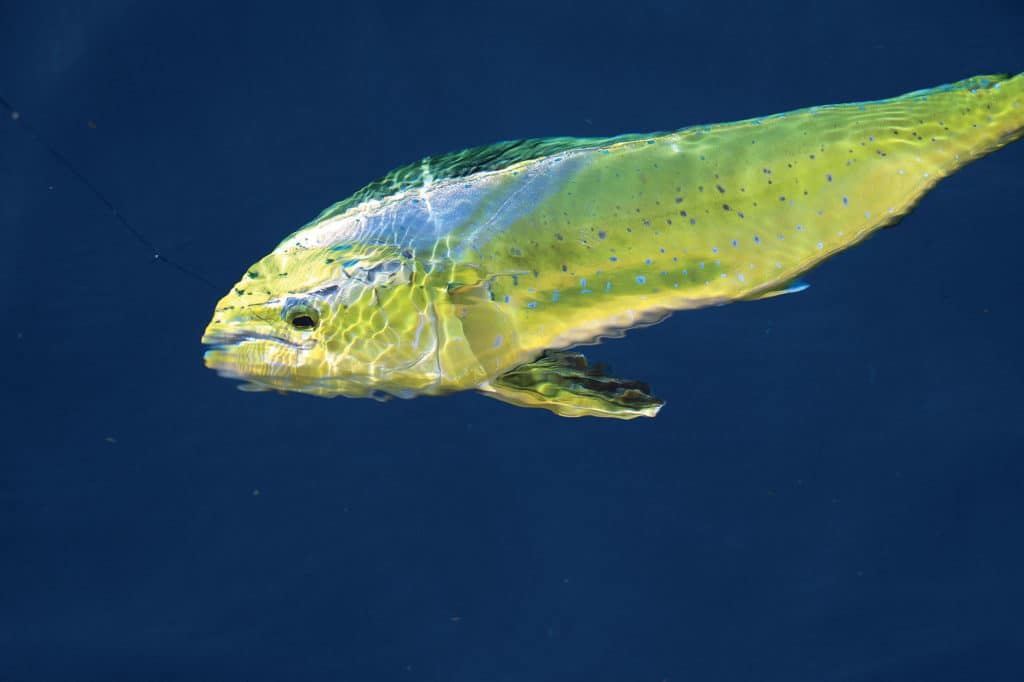
Mahi Interruption Aft of the helm seating, I found the 345’s workstation featuring a Corian countertop, cutting board, dual-basin sink with freshwater faucet and shower hose, electric grill, and stainless-steel drawer fridge/freezer. For additional seating, a three-person couch hydraulically deploys from within the workstation.
Before I could take a seat, however, the starboard rigger line snapped free, and a mahi sprang into the air 75 feet behind the boat. Connor battled the fish, using the padded coaming bolsters along the 27-inch-high gunwales to brace himself. He brought the mahi boatside for a few photos before releasing it. We saw more fish under weed lines and continued to slow-troll for a couple more hours, but we found no other takers. So we decided to reel in the lines and put the 345 through its paces.
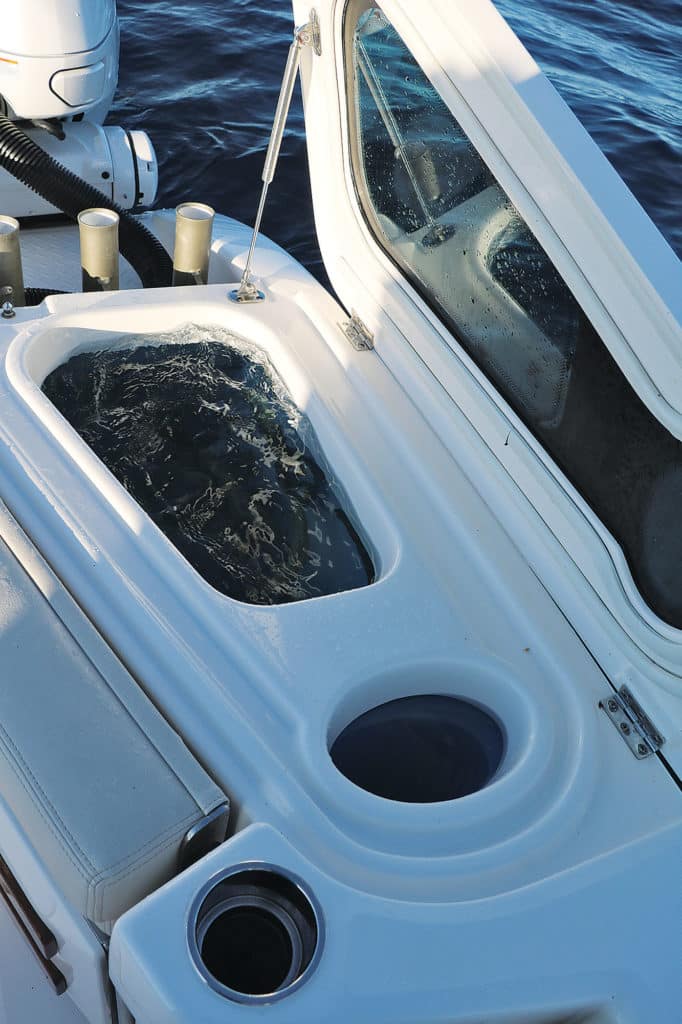
Numbers Game The twin Yamaha 425 XTOs propelled the 345 to plane in 7 seconds and 30 mph in 13.5 seconds. At 5,700 rpm, top speed was 55 mph, where outboards drank 72 gallons of fuel per hour for 0.76 mpg.
Throttling back, I found the best fuel efficiency at 4,000 rpm and 33.5 mph, where the engines consumed 33 gph for 1.02 mpg, resulting in a range of more than 300 miles based on the 323-gallon fuel capacity.
Read Next: Solace Boats 345 First Glance
The Solace 345 offers so many other features—including abundant stowage, retractable washdown hoses, folding stern seats, a deluxe sound system, an inverter and full-spectrum LED lighting throughout—that it is difficult to describe them all here. Suffice it to say, the Solace provides everything you can imagine in a top-of-the-line fishing boat, including the distinction of being one of today’s most innovative center‑console fishing boats.
Performance
Power: Twin Yamaha 425 XTO outboards Load: 125 gal. fuel, five crew Top Speed: 55 mph @ 5,700 rpm Time to 30 mph: 13.5 sec. Best MPG: 1.02 @ 33.5 mph (4,000 rpm)
Hull
LOA: 38 ft. (includes FishThru) Beam: 10 ft. 6 in. Transom Deadrise: 22 deg. Dry Weight: 12,000 lb. Draft: 1 ft. 10 in. Fuel: 323 gal. Max Power: 900 hp MSRP: $650,000 (base w/ twin Yamaha 425 XTOs)
Solace Boats Edgewater, Florida 386-302-6287 solaceboats.com

